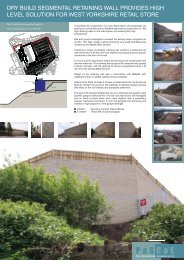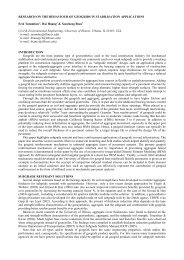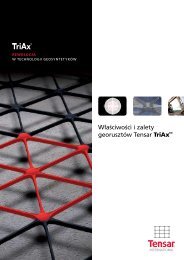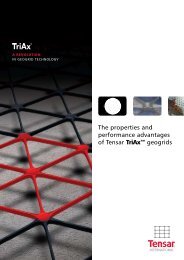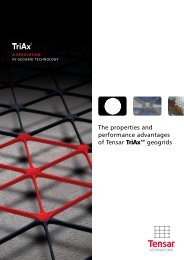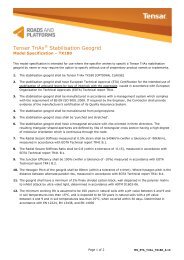3_JP Giroud_edited - Tensar International Ltd.
3_JP Giroud_edited - Tensar International Ltd.
3_JP Giroud_edited - Tensar International Ltd.
You also want an ePaper? Increase the reach of your titles
YUMPU automatically turns print PDFs into web optimized ePapers that Google loves.
expected to provide reinforcement. In fact, in some cases, a geotextile and a geogrid are used together: the geotextile<br />
to provide separation, and the geogrid (overlying the geotextile) to provide reinforcement.<br />
Reinforcement<br />
Geosynthetic reinforcement of unpaved roads and unpaved areas consists in improving load distribution and<br />
improving the subgrade bearing capacity.<br />
The geosynthetic improves load distribution through two mechanisms:<br />
• it improves the ability of the aggregate layer to distribute loads; and<br />
• it carries out load transfer through the “tensioned membrane effect”.<br />
The geosynthetic improves the subgrade bearing capacity by confining the subgrade soil. (The terminology<br />
“confinement of the subgrade soil” should be used with caution. It is macro-confinement, i.e. confinement on a large<br />
scale. In contrast, confinement provided to aggregate within the geogrid apertures is micro-confinement, i.e.<br />
confinement at the scale of the geogrid apertures.)<br />
The three reinforcement mechanisms (load distribution, tensioned membrane effect, and subgrade soil<br />
confinement) are discussed in the next section.<br />
Reinforcement mechanisms<br />
Improvement of load distribution by the aggregate layer<br />
A geosynthetic improves load distribution through two mechanisms: (i) by minimizing deterioration of the<br />
aggregate layer; and (ii) by increasing the ability of the aggregate layer to distribute loads. These two effects are<br />
discussed below.<br />
Geosynthetic reinforcement minimizes deterioration of the aggregate layer by preventing shear failure of the<br />
aggregate layer and lateral spreading of aggregate. Shear failure (or bearing capacity failure) of the aggregate layer is<br />
rare. Therefore, the main mechanism through which a geosynthetic prevents deterioration of the aggregate layer is by<br />
preventing or reducing lateral spreading of aggregate. This is achieved by interlocking between geogrid and aggregate.<br />
This mechanism does not exist with geotextiles.<br />
As mentioned previously in this paper, load distribution is provided by the aggregate layer. From a mechanical<br />
standpoint, the aggregate layer and the subgrade soil form a two-layer system. It is known from the theory of elasticity<br />
that, in a two-layer system, the stress distribution on the lower layer depends on the modulus of the upper layer. There<br />
is a significant stress distribution difference between a two-layer system and a uniform soil. An aggregate layer with a<br />
high modulus reduces drastically the maximum stress on the subgrade under the wheel. It is also known from the<br />
theory of elasticity that there are tensile stresses at the bottom of the upper layer, which weakens the upper layer and<br />
reduces the stress distribution effectiveness. Therefore, the stress distribution effectiveness of the upper layer can be<br />
increased by adding tensile stiffness at the bottom of the upper layer, hence the use of geosynthetic reinforcement at<br />
the bottom of the upper layer (i.e. the aggregate layer).<br />
It is important to note that just adding geosynthetic reinforcement at the bottom of the aggregate layer is not<br />
sufficient (especially with repeated loading). It is essential to impart tensile stiffness to the aggregate. To impart<br />
tensile stiffness to the aggregate at the bottom of the aggregate layer, there are two mechanisms: interface friction and<br />
interlocking. Interface friction exists between geotextile and aggregate and between some geogrids and aggregate.<br />
Interlocking is an interaction mechanism that is specific to geogrids. Due to its importance for geogrid-reinforced<br />
stabilisation structures, interlocking will be further discussed in a subsequent section.<br />
Load transfer by the tensioned membrane effect<br />
In addition to load distribution, geosynthetic reinforcement can contribute to load support through a mechanism<br />
called the “tensioned membrane effect”. The tensioned membrane effect has been extensively discussed because, in<br />
early attempts at explaining the behavior of unpaved roads, it was thought that the tensioned membrane effect was the<br />
main mechanism governing the performance of unpaved roads. It is known now that this is not the case.<br />
The tensioned membrane effect consists in decreasing the load induced in the subgrade soil under the wheels, by<br />
transferring part of this load to lateral zones (i.e. away from the wheels). The mechanism is the following. Due to the<br />
traffic loads, the geosynthetic is deformed and is, therefore, under tension. Under the wheels, due to rutting, the<br />
geosynthetic has a concave shape. The resultants (which are oriented upward) of the geosynthetic tensions on each<br />
side of the concave shape contribute to wheel support. These resultants are balanced by downward resultants<br />
associated with the convex shape of the geosynthetic away from the wheels.<br />
From this analysis, it is clear that the tensioned membrane effect requires rutting (in fact, deep rutting) and<br />
calculations show that, for typical rut depths, the tensioned membrane effect is negligible. Also, the tensioned<br />
membrane effect works only with channelized traffic (i.e. if traffic keeps deepening the same ruts). Traffic is not<br />
channelized in the case of unpaved areas and traffic may not be channelized in some wide unpaved roads.<br />
Thus, the tensioned membrane effect is not the main mechanism governing the behavior of unpaved roads and<br />
unpaved areas. The tensioned membrane effect is always negligible in geogrid-reinforced unpaved roads and unpaved<br />
areas, and it may carry only 10% of the load in geotextile-reinforced unpaved roads and unpaved areas that exhibit<br />
very deep ruts (<strong>Giroud</strong> et al. 1984).



